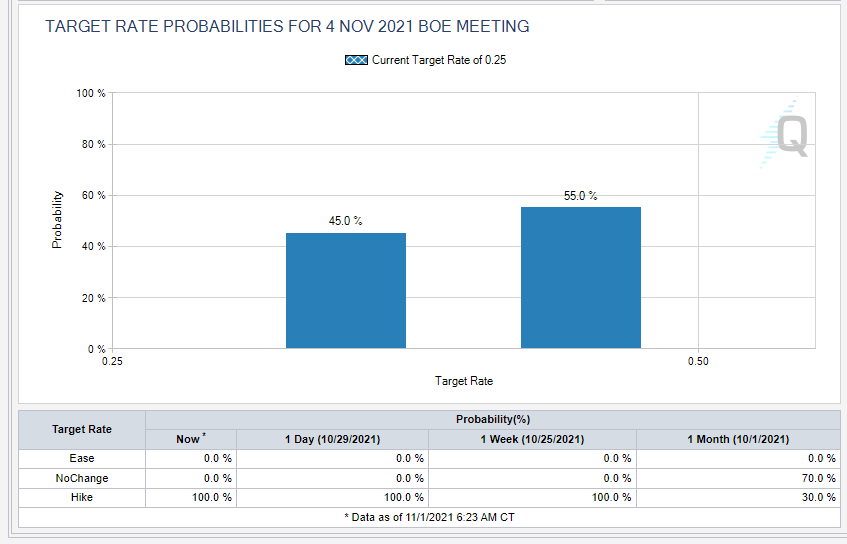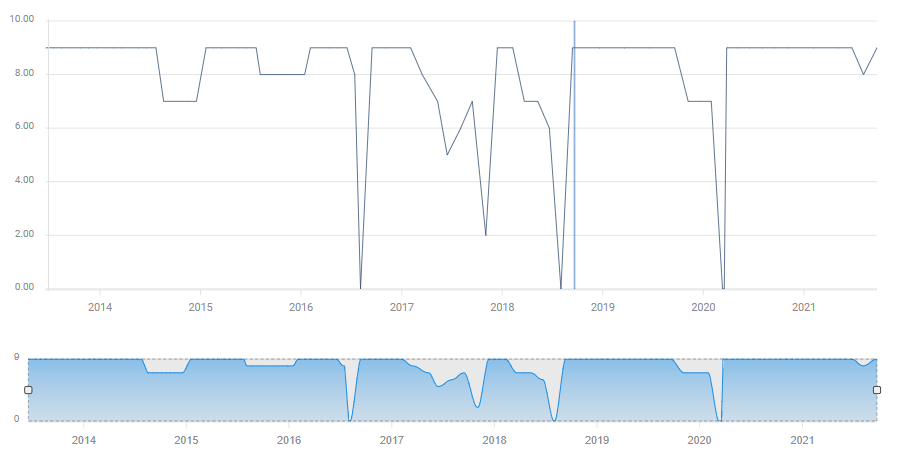- The BOE is set to refrain from a rate hike, yet a close call would shake the pound.
- Meeting minutes from the decision are set to show the divisions, providing insights on what's next.
- BOE Governor Bailey's leanings in the press conference will have the final say.
To hike or not to hike? In a rarity for markets, bonds are pricing a near coin-toss on the Bank of England's November decision. There are contrasting factors to consider, with a marginally higher chance that doves win this battle. Nevertheless, uncertainty is high and there are other two market-rocking events.
1) Time to act?
Less than 24 hours after the Federal Reserve's decision, traders will see a stark difference. While American policymakers clearly indicated their intention to announce tapering, the BOE's plans remain up in the air. At writing, bond markets are pricing a 55% chance of a hike, up from above 40% several days beforehand.
Why is uncertainty so high? While BOE Governor Andrew Bailey said the bank has to act, he did not specify when. Chief Economists Phil Huw seems keen to raise rates, but Silvana Terenyero – the last BOE member to talk about rates – sent a dovish message.
The lack of a clear direction cannot be solely blamed on communications as it is hard for the "Old Lady" – to assess how sticky inflation is. The headline Consumer Price Index (CPI) rose by 3.1% YoY in September, significantly above the BOE's 2% target. Global supply-chain issues have been compounded by Brexit-related shortages of lorry drivers and several goods on shelves, pushing prices higher.
Source: FXStreet
Developments in the labor market also cause some head-scratching. While the unemployment rate is down to 4.6% and wages are up, the expiry of the furlough scheme has yet to materialize fully.
Will job seekers that are left without support push salaries lower? Or are shortages of skilled workers in specific areas continue pushing costs higher?
Source: FXStreet
Another source of uncertainty comes from COVID-19. While most Brits are vaccinated, Britain lags behind some of its European peers and suffers from persistently high cases. The government's denial of considering restrictions only caused investors to fear that they would come. Even without official limits, the spread of the disease could cause people to shy away from public places, weighing on the economy and eventually pushing prices lower.
Will the BOE raise rates to fight inflation or wait longer? When in doubt, stay out, goes the adage relevant for traders. Central banks have been fighting to prevent deflation for years and waiting another month to hike borrowing costs from 0.10% to 0.25% seems to be the more cautious approach.
For the pound, the scenario is straightforward – jumping on a rate increase and tumbling otherwise.
2) How did members vote?
The BOE's Monetary Policy Committee (MPC) is a nine-member body with independently-minded participants. Contrary to the US Fed, the British institution also witnessed its Governor being outvoted by other members in the past.
Uninamity is common but dissent is not rare:
Source: FXStreet
If there is a large minority voting against the decision, it could either smooth the immediate reaction – minutes of the meeting are released alongside the decision – or trigger a rapid countertrend. That could cause some confusion in the immediate aftermath.
If the assessment presented here is correct and the BOE refrains from raising rates, a 6:3 or 5:4 vote would mean the BOE is itching to hike borrowing costs. It would trigger a bounce in the pound, especially if Bailey is within the minority.
In the opposite scenario of a decision to raise rates to 0.25%, a significant dovish opposition of three or four members would imply the decision was a closer call than earlier thought – suggesting additional moves may wait for longer. It could even cause investors to think the rate hike is a "one and done."
What happens if there is a large or even unanimous decision? An 8:1 and especially a 9:0 vote either to raise rates or hold back – something which seems unlikely given the public divisions – could trigger a stronger move in GBP/USD. In case of a hike, it could result in larger gains, while in case of a no-change decision, sterling could suffer even more. Investors are expecting a divided vote.
3) What does Bailey say about the future
The BOE publishes its decision, the minutes and the MPR at 12:00 GMT. The latter document includes inflation and growth forecasts, as well as broad commentary about the economy. However, with the focus on the future of interest rates, markets may be forgiven for ignoring the data and waiting for the governor to open his mouth at 12:30 GMT.
In case of a rate hike, will Bailey signal that more will come to battle rising inflation? Or will he stick indicate a "wait and see" approach after one move. In the former scenario, sterling shines, while in the latter, it sinks.
The same logic applies for a no-hike scenario. If Bailey says such a decision to wait was a close call and hints at a December hike, the pound would bounce. If he focuses on the weaker sides of the economy, it would plunge.
Conclusion
The BOE's rate decision is a rare coin-toss, and so are the voting patterns and the messages conveyed by the bank.
More: Fed Preview: Five dollar-moving things to watch out for on the historic tapering announcement
Information on these pages contains forward-looking statements that involve risks and uncertainties. Markets and instruments profiled on this page are for informational purposes only and should not in any way come across as a recommendation to buy or sell in these assets. You should do your own thorough research before making any investment decisions. FXStreet does not in any way guarantee that this information is free from mistakes, errors, or material misstatements. It also does not guarantee that this information is of a timely nature. Investing in Open Markets involves a great deal of risk, including the loss of all or a portion of your investment, as well as emotional distress. All risks, losses and costs associated with investing, including total loss of principal, are your responsibility. The views and opinions expressed in this article are those of the authors and do not necessarily reflect the official policy or position of FXStreet nor its advertisers. The author will not be held responsible for information that is found at the end of links posted on this page.
If not otherwise explicitly mentioned in the body of the article, at the time of writing, the author has no position in any stock mentioned in this article and no business relationship with any company mentioned. The author has not received compensation for writing this article, other than from FXStreet.
FXStreet and the author do not provide personalized recommendations. The author makes no representations as to the accuracy, completeness, or suitability of this information. FXStreet and the author will not be liable for any errors, omissions or any losses, injuries or damages arising from this information and its display or use. Errors and omissions excepted.
The author and FXStreet are not registered investment advisors and nothing in this article is intended to be investment advice.
Recommended Content
Editors’ Picks

EUR/USD struggles to hold above 1.0400 as mood sours
EUR/USD stays on the back foot and trades near 1.0400 following the earlier recovery attempt. In the absence of high-tier data releases, the cautious risk mood helps the US Dollar hold its ground and forces the pair to stretch lower.

GBP/USD declines below 1.2550 on renewed USD strength
GBP/USD loses its traction and trades below 1.2550 in the second half of the day on Monday. The US Dollar (USD) benefits from safe-haven flows and weighs on the pair as trading conditions remain thin heading into the Christmas holiday.

Gold drops to $2,620 area as US bond yields edge higher
Gold struggles to build on Friday's gains and trades modestly lower on the day near $2,620. The benchmark 10-year US Treasury bond yield edges slightly higher above 4.5%, making it difficult for XAU/USD to gather bullish momentum.

Bitcoin fails to recover as Metaplanet buys the dip
Bitcoin hovers around $95,000 on Monday after losing the progress made during Friday’s relief rally. The largest cryptocurrency hit a new all-time high at $108,353 on Tuesday but this was followed by a steep correction after the US Fed signaled fewer interest-rate cuts than previously anticipated for 2025.

Bank of England stays on hold, but a dovish front is building
Bank of England rates were maintained at 4.75% today, in line with expectations. However, the 6-3 vote split sent a moderately dovish signal to markets, prompting some dovish repricing and a weaker pound. We remain more dovish than market pricing for 2025.

Best Forex Brokers with Low Spreads
VERIFIED Low spreads are crucial for reducing trading costs. Explore top Forex brokers offering competitive spreads and high leverage. Compare options for EUR/USD, GBP/USD, USD/JPY, and Gold.



